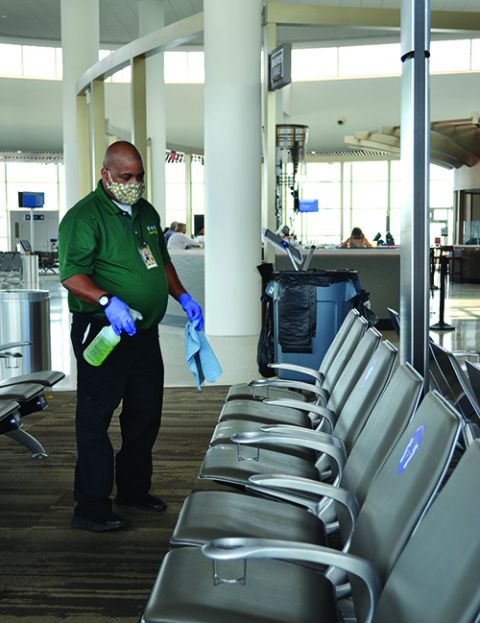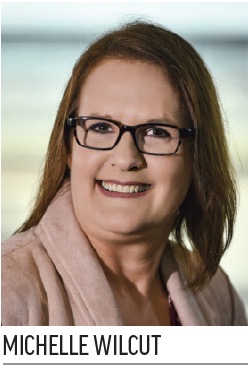New Orleans Int’l Brings Janitorial Management In-House

When Louis Armstrong New Orleans International Airport (MSY) officially opened the doors of its new terminal in November 2019, the facility gleamed. The concourses and updated finishes literally transformed the way nearly 25,000 passengers traveled through the airport each day.
 But shortly after the grand opening, cleaning challenges emerged that threatened the image and reputation of the city’s flagship airport.
But shortly after the grand opening, cleaning challenges emerged that threatened the image and reputation of the city’s flagship airport.
“We recognized almost immediately that the level of service that was being presented was not sufficient or satisfactory for our brand-new terminal,” says Airport Director Kevin Dolliole. “We decided that we wanted to provide janitorial services at the airport in a different manner that would not only be best for our customers, but also allow us the opportunity to be more hands-on.”
In December 2019—just one month after cutting the ribbon—Dolliole and other airport leaders began reshaping the status quo. Questions regarding the established strategy of outsourcing janitorial services to a third party prompted the airport to engage Confluence Solutions, a consulting firm that develops janitorial and other facility strategies for airports. The airport selected Confluence earlier to provide janitorial management consulting services. Working with its new consultant, MSY officially started the process of moving the management of janitorial services under the airport’s purview.
|
Project: In-House Janitorial Management Location: Louis Armstrong New Orleans Int’l Airport Owner: City of New Orleans Annual Passengers Traffic: 13 million Facility Size: 972,000 sq. ft. terminal with 3 concourses, 35 gates Annual Costs: $518,000 consulting fees; $4.1 million janitorial labor Transition Period: Dec. 2019-Feb. 2020 Consultant: Confluence Solutions Staffing: Henry Consulting Key Benefits: Improved cleanliness in terminal; increased productivity & reduced turnover of janitorial crews |
“The airport made a complete commitment to improve their janitorial services,” says Scott Murray, founder of Confluence Solutions. “I saw firsthand that the airport leadership was personally and financially committed, and willing, to make the investment to change the labor and training to get the results they wanted.”
A Clean Sweep
In January 2020, the New Orleans Aviation Board voted to end its existing $2.9 million annual cleaning contract within 30 days and switch to in-house management of janitorial services. The vote formally launched the plan developed with Murray to meet MSY’s cleaning needs by contracting with Henry Consulting, a temporary staffing firm, for janitorial labor. The airport was already using the company for some of its clerical and administrative staffing needs and simply increased the budget to include janitorial duties.
Confluence Solutions worked closely with Michelle Wilcut, MSY’s deputy director of aviation heading customer service, to develop a new cleaning plan for the still-new terminal. Specific details included desired staffing levels, cleaning standards and training initiatives. The project partners also established an overnight deep-cleaning crew to test for cleanliness and address areas that are deemed to need more attention, like TSA screening checkpoints and ticket counters. New training initiatives include a buddy program that has new hires working side-by-side with seasoned employees.
“We asked Confluence Solutions to take on a stronger role in the training and leadership of our janitorial team,” Wilcut explains. “Their knowledge and expertise was important—not just knowledge of janitorial services, but airport janitorial services.”
 She reports that the switch to in-house management, which officially started in February 2020, was a success for the airport and the workers who clean the terminal. Many were hired by Henry Consulting from the previous janitorial contractor’s workforce and received a pay raise and health benefits—a first for many of the workers and their families. The transition has improved productivity and reduced turnover, which had been a problem in the past, she adds.
She reports that the switch to in-house management, which officially started in February 2020, was a success for the airport and the workers who clean the terminal. Many were hired by Henry Consulting from the previous janitorial contractor’s workforce and received a pay raise and health benefits—a first for many of the workers and their families. The transition has improved productivity and reduced turnover, which had been a problem in the past, she adds.
“We saw a marked improvement and a better overall product in the airport by bringing the management of cleaning in-house and having airport janitorial professionals leading us through this transition,” says Wilcut.
COVID Clean
The airport was just beginning to operate under its new maintenance structure when the coronavirus pandemic struck the U.S. Naturally, the focus quickly shifted from having a terminal that looked clean to providing a COVID-healthy environment for employees, airport partners and the few travelers still using the facility.
With heightened sensitivity about cleaning measures, MSY adjusted its janitorial training program to emphasize the importance of having a safe, healthy facility for customers and staff. The airport also increased the frequency that high-traffic areas are cleaned. For instance, before COVID-19, crews typically cleaned gate areas two to three times per day. Now each gate is cleaned every hour, with extra attention applied to high-touch areas, such as seating arm rests, counters and handrails.
As airport director, Dolliole was keenly aware of specific changes. “We increased the level of cleaning, added functions and changed chemicals to provide a higher level of cleanliness and sanitization,” he says. “COVID caused budget reductions, and we had to make adjustments in a number of areas; but we didn’t want to touch our janitorial budget.”
Although MSY’s traffic dropped by 80%, janitorial staffing was only adjusted by about 20% because of the increase in cleaning frequency and additional areas of focus. Expenditures for supplies increased because more cleaning agents and disinfectants are now needed to sanitize the facility.

Changing Strategies
When reviewing their janitorial options, Dolliole and other airport leaders focused on finding a solution that included the right staff to help improve their customers’ experience at the terminal.
 “Any airport that wants to bring these types of services in-house should consult with a trusted facilities specialist to help them to delve deeper to better understand their needs and how they can best meet those requirements,” Murray advises.
“Any airport that wants to bring these types of services in-house should consult with a trusted facilities specialist to help them to delve deeper to better understand their needs and how they can best meet those requirements,” Murray advises.
MSY outsourced its entire janitorial program for decades before making the transition. Now, the airport plans to continue the move to in-house by adding airport staff to supervise its janitorial services.
“Our decision to work with an industry consultant and make the change to in-house management of our janitorial team has proven to be the right and best option for the airport,” Dolliole concludes. “We’re very happy with our decision, the consulting support and end result.”

FREE Whitepaper
Fairbanks International Airport Baggage Transport Conveyor Enhanced With Mod Drive™ System
Airports face a host of unique industry challenges, such as meeting efficiency regulations and seeking out the best maintenance practices to reduce costs and keep operations flowing. In today’s current economic climate, any potential cost savings can go a long way.
In 2019, Alaska’s Fairbanks International Airport (FAI) sought to modernize its equipment and operations. They were dissatisfied with the performance of the gearmotors on their baggage transport conveyors and began searching for new suppliers. Regal approached FAI with a solution that could improve equipment performance and simplify maintenance, with the added benefit of energy cost savings: the Hub City® MOD Drive™ system.
This white paper discusses the hardware deployed, the test results and the annualized expectations for ROI.
 facts&figures
facts&figures








